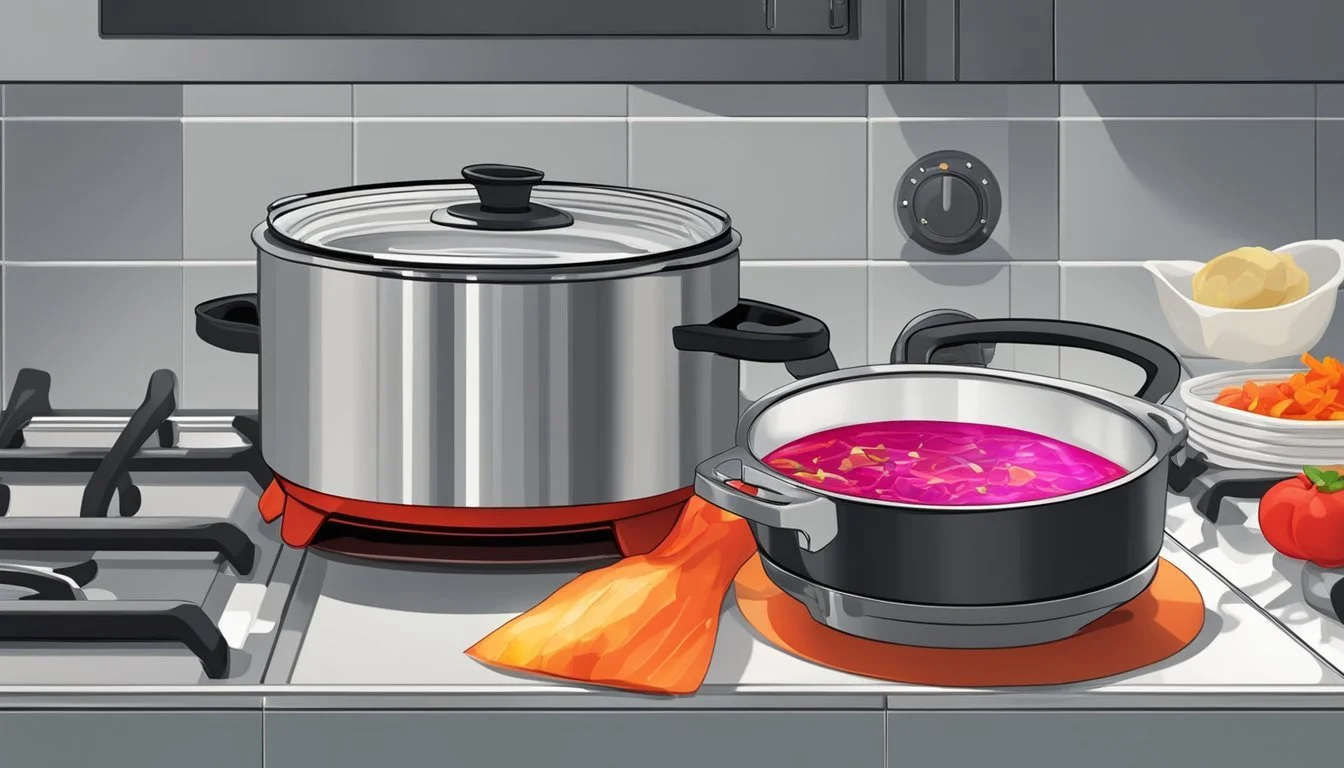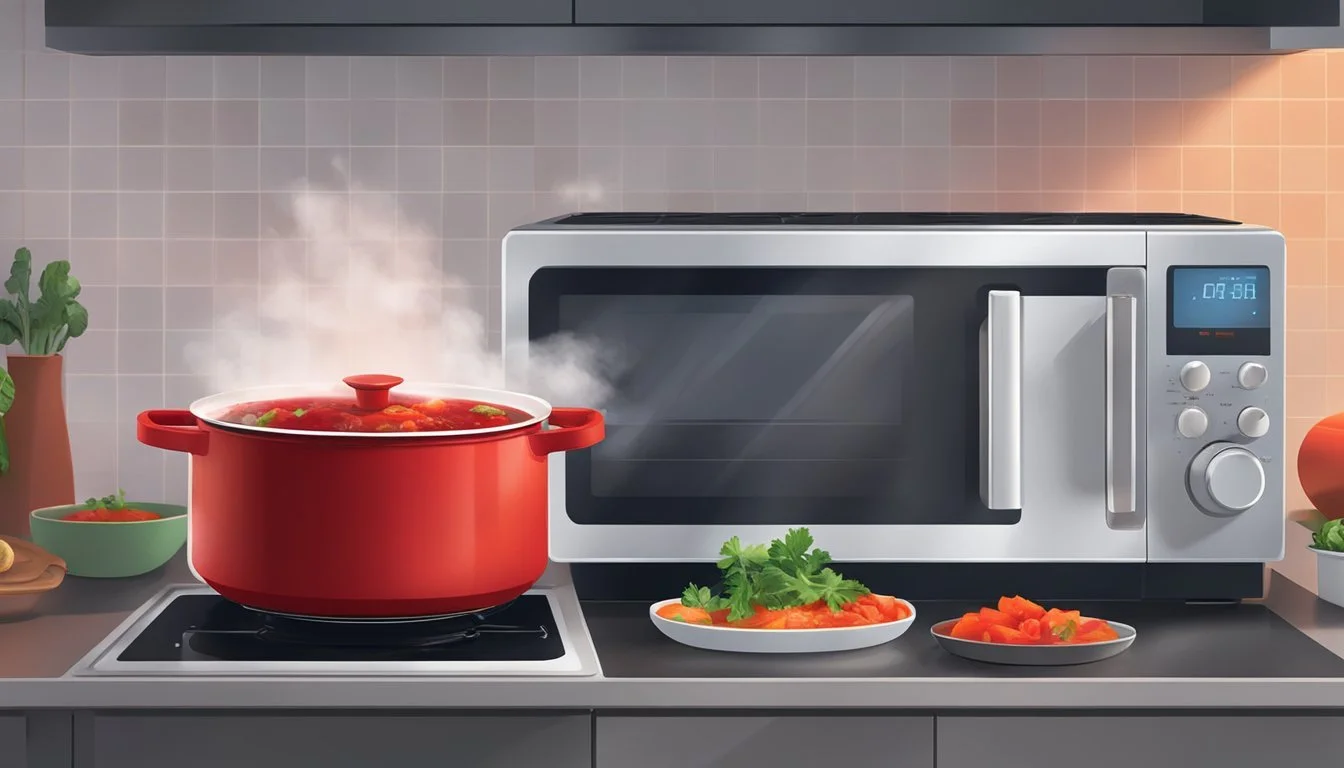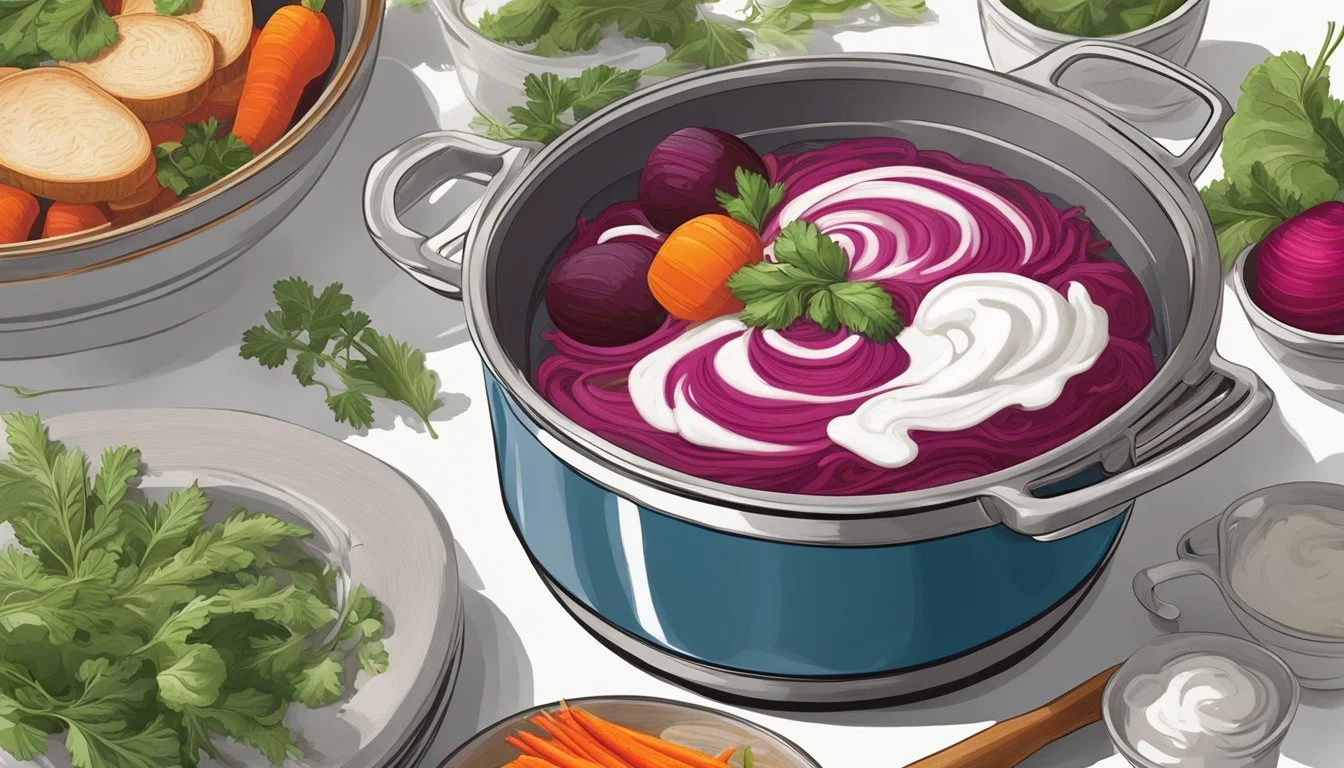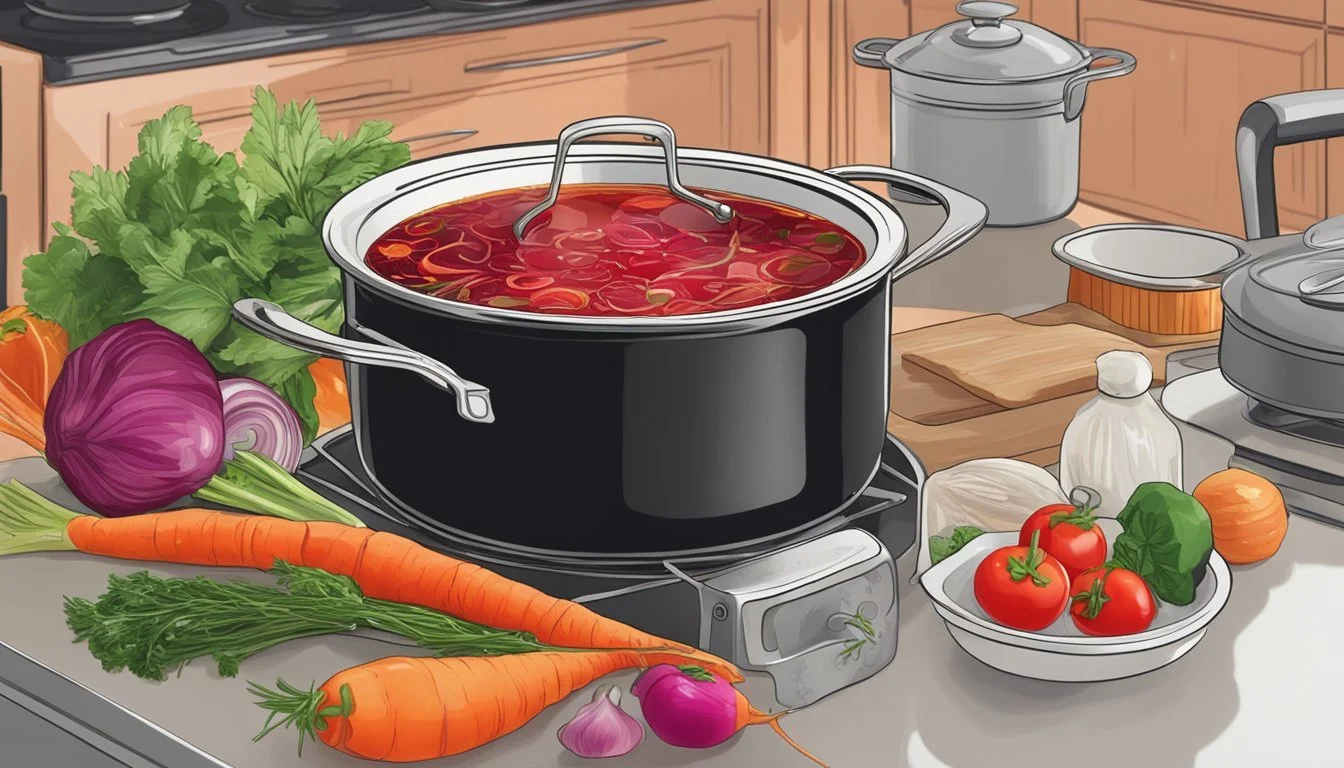Best Way to Reheat Borscht
Tips for Preserving Its Color and Flavor
Borscht, the classic Eastern European soup known for its distinctive ruby hue and nutritious blend of vegetables, is a dish celebrated for both its taste and visual appeal. The key to enjoying leftover borscht is to reheat it in a way that preserves its vibrant color and texture. Since borscht contains beets, which lend the soup its rich color, proper reheating is crucial to prevent the loss of this characteristic.
Safeguarding the soup's color starts with understanding the properties of beets and how they react to heat. When reheated improperly, beets can turn a dull brownish color, significantly impacting the visual aspect of the soup. Reheating borscht is a delicate process that should be done gently and slowly, using methods that distribute heat evenly without overcooking the ingredients.
Maintaining the integrity of the soup's components, such as the tender chunks of vegetables and the robust broth, is essential for the best tasting experience. Care must be taken to ensure that the reheating process does not result in the vegetables becoming mushy or the flavors becoming muted. With the right technique, borscht can be reheated to a temperature that is both safe to eat and pleasant to taste, all the while retaining the characteristics that make this dish a beloved comfort food.
Understanding Borscht
Borscht is not only a culinary staple in Eastern Europe but also a dish rich in nutrients, offering a combination of health benefits and cultural heritage.
Historical Background
Borscht originated in Eastern Europe, with a strong historical presence in Ukrainian and Russian cuisine. This hearty soup typically features a distinct red color thanks to its primary ingredient, beetroots. Although recipes vary by region and family tradition, the core elements of borscht have traversed generations, symbolizing the rich cultural tapestry of the areas from which it hails.
Nutritional Profile
Fiber: Borscht is high in fiber, mainly due to its primary ingredient, beets, and other vegetables such as cabbage.
Protein: While the soup can be vegetarian, many traditional recipes include meat, which increases its protein content.
Vitamin C: The vegetables in borscht, particularly beets, are excellent sources of vitamin C.
Nutrition: Overall, it's considered a healthy option, packed with various nutrients while staying low in calories.
By understanding borscht's origins and its nutrient composition, one appreciates both its cultural significance and its place in a balanced diet.
Essential Ingredients for Borscht
The success of a borscht recipe hinges on incorporating key vegetables and a base of meat or suitable alternatives that bring richness and depth to the broth.
Vegetable Components
The vibrancy of borschet is largely due to its vegetable ingredients.
Beets: Indispensable for borscht, beets bestow the soup with its iconic deep red color and earthy sweetness. Typically, they are grated or diced.
Cabbage: It adds a slight crunch and a savory element to the soup; half a head is shredded for a balanced texture.
Carrots: Often shredded or cut into matchsticks, carrots contribute a subtle sweetness and bright color.
Potatoes: Cubed potatoes provide heartiness and help thicken the soup, making it more satisfying.
Onions: A foundational flavor, onions are usually diced and sautéed until translucent.
For a vegetarian or vegan borscht, these vegetables are the stars, and one ensures that any stock or accompanying ingredients align with plant-based dietary requirements.
Meat and Alternatives
While traditional borscht often includes a meat component, alternatives can be used to suit varied diets.
Beef or Pork: A bone-in cut imparts a rich flavor as it simmers; beef is traditional, but pork is also common.
Kidney Beans or Beans: For a vegetarian alternative, beans add protein and texture. Kidney beans are a popular choice.
Meat Alternatives: Vegan options include plant-based meats, which mimic the role of traditional meat. They're added for protein and to enhance the soup's robustness.
The use of meat or meat alternatives contributes to the complexity of the broth, establishing a full-bodied flavor profile that complements the potent vegetable components.
Seasonings and Flavor Enhancers
When reheating borscht, one must consider the seasonings and flavor enhancers that not only maintain but also can enhance the soup's vibrant color and rich taste. Adding certain herbs and spices as well as adjusting the sour components can help achieve this.
Herbs and Spices
The judicious use of herbs and spices is essential for keeping the integrity of borscht's flavor. Dill is a classic herb that is often used for its fresh, slightly sweet taste and ability to enhance the soup's earthiness without overpowering other flavors. A pinch of salt can help to amplify the existing flavors, and a dash of black pepper adds a subtle heat that complements the beetroot's sweetness. Bay leaves are another traditional component that should be included during the reheating process to infuse the borscht with their unique, aromatic flavor. Additionally, a small amount of sugar can be used sparingly to balance the acidity and accentuate the natural sweetness of the vegetables.
Sour Notes
The sour element in borscht is pivotal to its taste profile. One can use either vinegar or lemon juice for adding acidity which helps in preserving the borscht's radiant color and bringing out its complex flavors. Vinegar should be added gradually, to taste, as it is potent and can easily dominate the dish. Lemon juice offers a fresher, more citrus-forward tang. For a creamy twist and added tang, one may incorporate a dollop of sour cream upon serving, which provides a rich and velvety finish to the soup.
Cooking Techniques for Borscht
The cooking techniques for traditional borscht focus on maintaining the integrity of the broth and the texture of the vegetables throughout the cooking process.
Preparing the Broth
For a rich and flavorful base, the broth should be prepared with care. When making traditional borscht, beef or chicken broth is commonly used, although vegetarian options can include vegetable stock or water. The key to a great broth is a gentle simmering process, allowing the flavors to meld without boiling vigorously, which can make the broth cloudy. If starting with meat, one should:
Bring the broth and meat to a low boil.
Skim off any foam that rises to the top.
Reduce heat and simmer for approximately 1 1/2 hours to extract deep flavors.
Boiling Vegetables
Boiling vegetables properly is crucial for vibrant borscht. The sequence in which vegetables are added to the soup impacts both flavor and color:
Potatoes: Cube and boil potatoes until fork-tender. Start with them in cold, salted water and bring to a boil.
Beets: To preserve the bright red color, beets should be added after the broth has been simmered and the foam removed. Shredded beets need to be sautéed in oil before being introduced to the pot to lock in color.
Other Vegetables: Onions and carrots are typically sautéed until tender before adding. Bell peppers, if used, should be cut into matchsticks and can be sautéed with onions and carrots.
Cooking vegetables in stages and avoiding over-boiling are essential to maintain their vibrant colors and textures.
Reheating Borscht
When reheating borscht, one aims to preserve its vibrant red color while warming it to the appropriate serving temperature. The techniques and precautions discussed below ensure that the integrity of borscht's color and flavor is maintained.
Maintaining Vibrant Color
To keep the borscht's vibrant red color intact, it is essential to avoid prolonged heating and high temperatures. Gentle and gradual warming is key. Borscht's bright hue is often attributed to the betalains in beets, which are heat sensitive. Thus, reheating should be done carefully to prevent the color from dulling.
Tips for Color Preservation:
Avoid High Heat: Reheat on a low to medium setting.
Short Heating Times: Warm the borscht just until it reaches serving temperature. Overheating can cause color loss.
Heating Methods
Determining the best method to reheat borscht depends on maintaining its quality and color while considering convenience.
Stovetop:
Medium Heat: Reheat in a pot on the stove over medium heat.
Stir Occasionally: This prevents sticking and ensures even heating.
Microwave:
Low Power Setting: Use a low power setting and heat in short intervals.
Covered: Cover with a microwave-safe lid or paper towel to promote even heat distribution and retain moisture.
General Guidelines:
Gradual Warming: Whether on the stove or in the microwave, gradually warming the soup helps maintain its vibrant red color.
Leftovers: If the borscht was previously frozen, thaw in the refrigerator before reheating.
Storing Borscht
Proper storage is crucial for maintaining the freshness and vibrant color of borscht. By following appropriate refrigeration or freezing techniques, one can enjoy this hearty soup for days or even months to come.
Refrigeration Tips
When refrigerating borscht, one should allow the soup to cool to room temperature before transferring it to an airtight container. This minimizes the risk of bacterial growth and helps maintain the soup's quality. Borscht can be safely stored in the refrigerator for up to 3-4 days. To ensure the soup remains vibrant and fresh, it's important to:
Cool Down: Let the borscht cool for no more than two hours before refrigerating to prevent bacterial growth.
Airtight Containers: Transfer to an airtight container to keep out moisture and other contaminants.
Layer of Fat: If a layer of fat forms on the top, one can either remove it before reheating or leave it to act as a seal that may help preserve the borscht.
Freezing Advice
For longer storage, freezing borscht is an effective option. Freezing can extend the soup's life by several months, but there are key points to remember to ensure the soup retains its quality:
Portion Size: Freeze borscht in individual serving sizes for easy thawing and reheating.
Leave Room for Expansion: Do not fill containers to the brim; leave about an inch of space to allow for expansion as the borscht freezes.
Thawing: Thaw frozen borscht in the refrigerator overnight rather than at room temperature to reduce the risk of bacterial growth.
Labeling each container with the date of storage is also important for tracking how long the borscht has been frozen and ensuring it is used within an optimal time frame.
Serving and Garnishing
When presenting borscht, one should focus on maintaining the soup's vibrant hue and complementing its flavors with appropriate accompaniments and garnishes.
Accompaniments
Borscht is often served with sides that can soak up its rich flavors. Traditional accompaniments include:
Pampushky: These are small Ukrainian garlic bread rolls that pair exceptionally well with borscht.
Rye Bread: A slice of hearty rye bread complements the soup and adds a satisfying crunch.
Garnishing for Appeal
The final touch to borscht is its garnish, which enhances both the flavor and appearance:
Sour Cream: A dollop of sour cream on top of the hot borscht not only adds a creamy tartness but also creates a visually appealing swirl when stirred in.
Fresh Parsley: Chopped fresh parsley sprinkled over the soup adds a pop of green color, introducing a fresh herbal note to each serving.
Dietary Considerations and Variations
When reheating borscht, it's important to consider dietary restrictions and the dish’s regional variations to maintain its integrity and vibrant color.
Adapting for Special Diets
For those following vegetarian or vegan diets, borscht can be easily adapted. Traditional Ukrainian borscht often uses beef broth, but one can substitute it with vegetable broth. Beets, the primary ingredient in red borscht, are naturally gluten-free, making borscht suitable for those with gluten sensitivities. However, ensure that any added thickeners or seasonings are gluten-free. To address a low-sodium diet, reduce or omit added salt and use a low-sodium broth.
Vegetarian/Vegan: Use vegetable broth; omit meat and sour cream or use dairy-free alternatives.
Gluten-Free: Confirm all ingredients, including thickeners and seasonings, are gluten-free.
Low-Sodium: Use low-sodium broth and limit added salt.
Regional Varieties
Borscht varies by region, each with its own distinct style. Polish borscht, for example, might include white beans and is typically enjoyed during the Christmas season. Green borscht, often seen in Ukrainian cuisine, includes sorrel leaves, which contribute to its bright green color.
When reheating these variations, one must be mindful of the ingredients that are characteristic of each to preserve their unique qualities.
Ukrainian Borscht: May include meat or beans, beets, and a variety of vegetables; served with a dollop of sour cream.
Polish Borscht: Often has a clear base with beets, possibly white beans, and is served with a side of uszka (small dumplings).
Variation: For green borscht with sorrel, gentle reheating is essential to keep its color; red borscht may require a splash of lemon juice or vinegar to maintain its vibrant hue.
By considering these diets and regional differences, one can enhance the experience of enjoying borscht while being inclusive of various dietary needs and cultural traditions.
Utensils and Cookware
When reheating borscht to preserve its vibrant color, the choice of utensils and cookware is crucial. Utilizing the right equipment can prevent discoloration and ensure an evenly warmed soup.
Dutch Oven: A Dutch oven is an excellent choice for reheating borscht. Its heavy-duty construction distributes heat evenly, which is important to prevent the beets from losing their color due to sudden temperature changes. Moreover, the enamel coating on many Dutch ovens can help protect the soup's vibrant hue.
Pros of Using a Dutch Oven Cons of Using a Dutch Oven Even heat distribution Heavier than most pots Protection of soup color May retain heat longer, careful temperature management needed
Pot: A standard pot can also be used for reheating borscht. When opting for a pot, one should prefer a stainless-steel variant as it doesn't react with the acidic components of the soup which can alter the color.
It's recommended to use a pot with a thick bottom to avoid hot spots that might cause the soup to overheat in areas and thus lead to discoloration.
Pots with a lid are preferable to retain moisture and heat, which assists in even reheating.
To maintain the borscht's color:
Always ensure a slow and gentle reheating process, regardless of the cookware.
Avoid high heat as it may cause the bright red pigments, betalains, to dull.
Stir occasionally with a wooden or silicone spoon to promote even temperature distribution throughout the soup.
In conclusion, whether one chooses a Dutch oven or a pot, key considerations should include materials that do not react with the soup's ingredients, and cookware that can provide consistent heat for a gentle reheating process.
Conclusion
Reheating borscht effectively preserves its vibrant color and robust flavors when approached with care. Firstly, gentle reheating is crucial; a low and slow approach on the stovetop helps maintain the integrity of the borscht. One should avoid boiling, as high temperatures can dull the beet's rich hue.
Secondly, incorporating a splash of acidic ingredient, such as lemon juice or vinegar, just before serving can enhance the color and add a freshness to the taste. It's important that these acidic components are added during the reheating process and not before freezing or long-term storage, as they can affect the texture of vegetables over time.
For those with a microwave, heating in short intervals and stirring in between can prevent uneven temperatures, which might otherwise lead to a loss of color and a less desirable texture.
In summary, the key to reheating borscht without losing its color lies in:
Reheating on the stovetop at low temperatures
Avoiding boiling to preserve color
Using acidic ingredients to brighten the hue
Opting for interval reheating in a microwave to maintain even temperatures
By following these suggestions, one ensures that the reheated borscht is as visually appealing and delicious as when it was first served.










